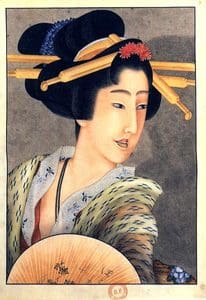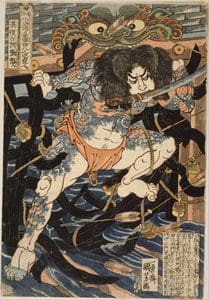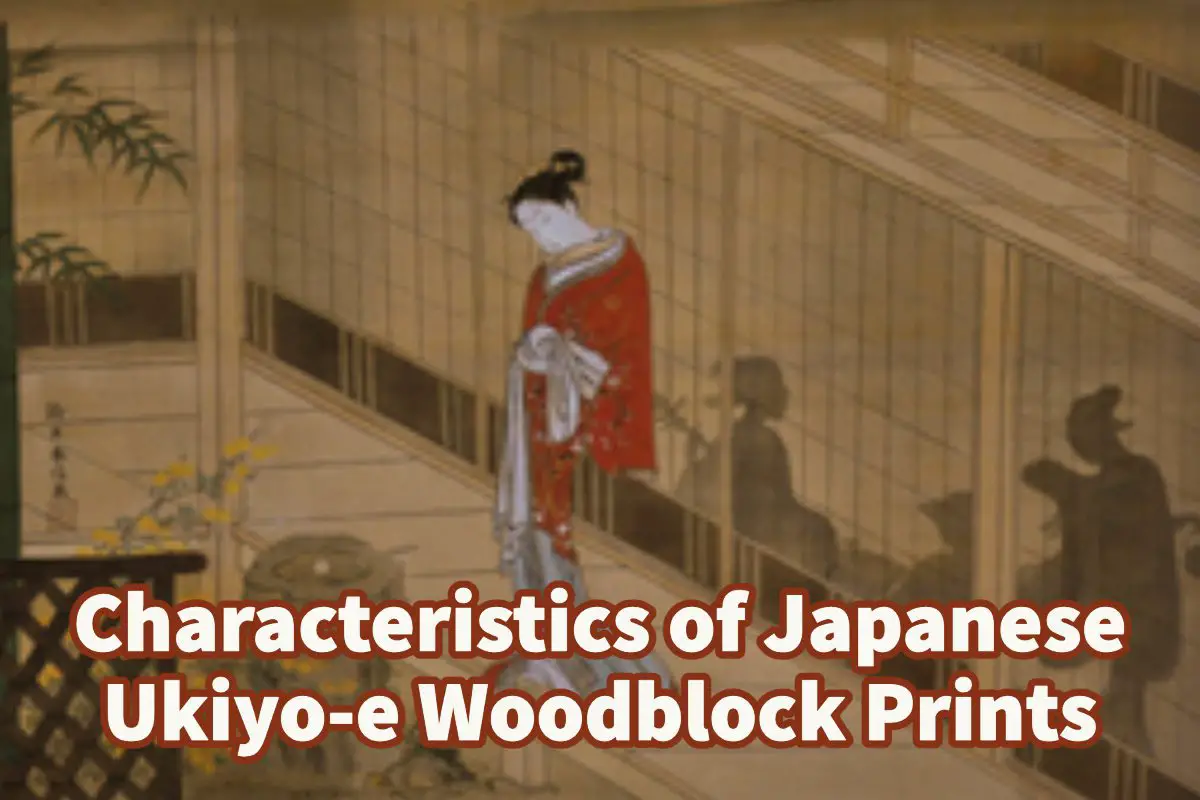The Japanese woodblock prints, also known as the Ukiyo-e period of Japanese woodblock print production, are from the 1670s to the 1900s. The name Ukiyo-e means “pictures of the floating world.”
Japanese woodblock prints were produced to have a mass appeal to the Japanese audience. There are a lot of characteristics in Japanese woodblock print, such as the asymmetry of design, how the artist experiments with composition, the artist’s use of flat spaces, and the use of colors.
Table of Contents
- Ukiyo-e: The Art of Japanese Woodblock Prints from 1670s to 1900s Characteristics
- Frequently Asked Questions
- Related Questions
Ukiyo-e: The Art of Japanese Woodblock Prints from 1670s to 1900s Characteristics
Spanning from the 1670s to the 1900s, the Ukiyo-e era marks a significant period in the history of Japanese woodblock printmaking. Ukiyo-e, which translates to “pictures of the floating world,” reflects a unique artistic perspective that resonated widely with the Japanese populace.
These prints are distinguished by their distinctive design elements, which include asymmetrical layouts, innovative composition techniques, the strategic use of flat areas, and a rich palette of colors.
This artistic approach not only captivated a broad audience but also played a pivotal role in shaping the aesthetic sensibilities of the period.
When you understand these Japanese woodblock prints, you also understand why so many artists have been influenced by them and the styles they used in their woodblock printmaking. Here Are Some Characteristics Of Japanese Ukiyo-e Woodblock Prints
Mass Appeal
What makes the Japanese woodblock prints unique from other works of art is these woodblock prints were made for mass appeal. In other words, everyone could afford them and have them in their home; they were commercialized art prints during this period.
These prints were known as floating pictures of the world, but they showed ordinary people, urban life, brothel quarters, and Kabuki theatre. They also included other popular motifs such as birds, flowers, and landscapes.
They pretty much covered most aspects of Japanese life at the time.

Asymmetry Of Design
Many Japanese woodblock prints during the Ukiyo-e period were asymmetrical; the woodblock prints failed to have parts that correspond with one another as far as shape size or arrangement. In other words, they lacked symmetry.
This is probably one of the best well-known aspects of the overall design of Japanese woodblock prints because they have asymmetry. The woodblock artists did not produce symmetry but produced them for what they saw as artists.
Experiments in Composition
The Japanese Ukiyo-e shows us a lot of experimentation in composition. This is why you often see that some objects may be truncated or even cut off or shortened. The composition is done this way so that the viewer wants to know what is next or hidden from our view.
Many Time Simple
Many of the drawings may be simple rather than busy. This does not mean the subject matter is simple, but the artist may have used a drawing technique to simplify some subjects.
Use of Flat Color
Many of the Japanese Ukiyo-e artists fully understood the power of flat color. You will find some flatness on parts of the woodblock prints and then depth and detail on others. The Japanese woodblock print artists were masters at understanding how and when to use flat color.
Black Outlines
The Japanese Ukiyo-e artist used a lot of black lines in their work. Sometimes they outlined figures and others with black lines. They understood how and when to use the black lines.
These black lines often helped produce a strong sense of movement and other times, they helped dominate onto a particular part of the woodblock print.
Bright Colors
The woodblock prints were not dull but usually were bright. They purposely choose a bright color to convey their message fully.

Images With Narrative
Many of the images had a narrative to them. This would be some writing or description for the woodblock print itself. The narrative is used to emphasize something for the woodblock print.
Produced in Sets
Many of the woodblock prints were reproduced in sets such as three panels or a series. This gave the woodblock prints some continuity in the production, printing, and message.
Shows Movement
Japanese woodblock prints show movements. Whether it’s a wave that’s about ready to crash down onto a boat or people doing something routine, the images usually include some movement.
This often showed people in everyday life doing some work or doing something as a woman kneeling to serve tea or a Japanese warrior ready to fight. The woodblock prints give you some feeling that an action is about ready to happen at any moment.
Along with this movement, we usually find a sort of rhythm within the painting itself. And this rhythm is how your eyes will move around the woodblock print from one part to another. These Japanese artists were masters of this movement and rhythm.
Repetitions Is Used
A lot of the artwork used repetition within the artwork. Whether the same motif is painted again and again or an article of clothing with repeated motifs or dots on it. There’s a lot of repetition that is used in many parts of the woodblock prints.
The continual repetition of color and form helps to give continuity to the entire woodblock print.
Cultural Meaning
Many of the woodblock prints have cultural meanings to them. They will contain some images of everyday Japanese life. The audience was able to connect them to a broader meaning of Japanese life.
The Japanese woodblock prints also give us a glimpse into life in 17th, 18th, and 19th century Japan.
I’m a massive fan of Japanese woodblock prints. I find them inspiring – they inspire my artwork.
Frequently Asked Questions
What is Ukiyo-e, and what does the term “pictures of the floating world” signify in the context of Japanese woodblock prints?
The term Ukiyo-e translates to “pictures of the floating world” and refers to a genre of Japanese woodblock prints depicting scenes from the urban lifestyle and entertainment of the Edo period (17th-19th centuries).
How did Japanese woodblock artists experiment with composition in Ukiyo-e prints?
Artists often played with asymmetry, using unconventional compositions to create dynamic and visually striking images. This experimentation added a unique and captivating quality to the prints.
What role did flat spaces play in Japanese woodblock prints, and how did artists utilize them in their designs?
Artists purposefully employed flat spaces to emphasize certain elements of the composition, creating a balance between detailed areas and open, unembellished regions within the print.
How did the Ukiyo-e prints achieve mass appeal to the Japanese audience?
Ukiyo-e prints were affordable and accessible, making them popular among a broad spectrum of society. The subject matter, often portraying actors, landscapes, and beautiful women, resonated with the public’s interests.
What significance does color hold in Japanese woodblock prints, and how did artists utilize it to enhance their creations?
Artists used a vibrant color palette to evoke mood and atmosphere in their prints. Bold and contrasting colors were employed to highlight specific elements, contributing to the overall visual impact.
Can you elaborate on the theme of asymmetry in Ukiyo-e prints and how it influenced the overall aesthetic?
Asymmetry in design added a sense of dynamism and movement to the prints. Artists purposefully avoided strict symmetry, opting for unbalanced compositions that engaged the viewer’s eye and conveyed a lively energy.
Were there specific subjects or themes commonly depicted in Japanese woodblock prints, and if so, what were they?
Common themes included kabuki actors, beautiful women (bijin-ga), landscapes, historical scenes, and scenes from literature. These subjects captured the essence of the floating world and everyday life.
How did the Ukiyo-e artists capture the essence of urban life in their prints?
Urban life was portrayed through scenes of bustling streets, theaters, teahouses, and other places of entertainment. These depictions provided a glimpse into the vibrant and lively culture of Edo-period Japan.
What printing techniques were employed in the production of Ukiyo-e woodblock prints?
Ukiyo-e prints were typically produced using a collaborative process involving an artist, a carver, and a printer. The technique involved carving separate blocks for each color, allowing for intricate and multicolored prints.
Did the popularity of Ukiyo-e prints extend beyond Japan, and if so, how did they influence Western art?
Yes, Ukiyo-e prints gained popularity in the West during the late 19th century, influencing prominent Western artists such as Vincent van Gogh and Claude Monet. The aesthetic and techniques of Japanese woodblock prints left a lasting impact on the development of Western art movements like Impressionism.
Anita Louise Art is dedicated to art education, great artists, and inspiring others to find and create their art. We love art that uplifts and inspires. #ArtToMakeYouSmile! #ArtToMakeYouHappy!
If you are interested in seeing any of my art, you can find out more by clicking here. If you are interested in what inspires me and my paintings, you can discover more by clicking here.
We have a free newsletter and would love you to be part of our community; you can subscribe to the newsletter by clicking here. If you have any questions, I would be happy to talk to you. You can reach me, Anita, by clicking here.
Subscribe to our Anita Louise Art YouTube Channel filled with great videos and information by clicking here.
Join us for our podcast “5 Minutes With Art.” Spend just 5 minutes a week with us to discover and learn about great art and artists. You can find out more about our podcast by clicking here.
Related Questions
What Are Some Japanese Woodblock Print Characteristics?
There are many characteristics of a Japanese woodblock print, from the woodblock print title, artist name, and publisher’s seal; other features also include the color and subject matter. Japanese woodblock prints also have different artistic art movements.
By clicking here, you can learn more by reading What Are Some Japanese Woodblock Print Characteristics?.
What Is A Japanese Woodblock Print?
A Japanese woodblock print is, as the name implies, a print that is made by using carved woodblock and applying ink on the woodblocks to print a design on paper. The Japanese woodblock artists used the woodblocks to print artistic prints and even books. Artists have used the woodblock print technique in Japan for hundreds of years.
You can learn more by reading What Is A Japanese Woodblock Print? by clicking here.


